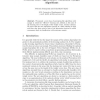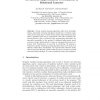ECML
2006
Springer
14 years 3 months ago
2006
Springer
Nearest neighbor forecasting models are attractive with their simplicity and the ability to predict complex nonlinear behavior. They rely on the assumption that observations simila...
ECML
2006
Springer
14 years 3 months ago
2006
Springer
Semi-supervised clustering uses the limited background knowledge to aid unsupervised clustering algorithms. Recently, a kernel method for semi-supervised clustering has been introd...
ECML
2006
Springer
14 years 3 months ago
2006
Springer
A critical problem in clustering research is the definition of a proper metric to measure distances between points. Semi-supervised clustering uses the information provided by the ...
ECML
2006
Springer
14 years 3 months ago
2006
Springer
Abstract. In this paper, we propose a new method for learning to rank. `Ranking SVM' is a method for performing the task. It formulizes the problem as that of binary classific...
ECML
2006
Springer
14 years 3 months ago
2006
Springer
This paper presents a decoupled two stage solution to the multiple-instance learning (MIL) problem. With a constructed affinity matrix to reflect the instance relations, a modified...
ECML
2006
Springer
14 years 3 months ago
2006
Springer
ECML
2006
Springer
14 years 3 months ago
2006
Springer
We present a new class of perceptron-like algorithms with margin in which the "effective" learning rate, defined as the ratio of the learning rate to the length of the we...
ECML
2006
Springer
14 years 3 months ago
2006
Springer
We describe a reinforcement learning system that transfers skills from a previously learned source task to a related target task. The system uses inductive logic programming to ana...
ECML
2006
Springer
14 years 3 months ago
2006
Springer
Abstract. Greedy machine learning algorithms suffer from shortsightedness, potentially returning suboptimal models due to limited exploration of the search space. Greedy search mis...
ECML
2006
Springer
14 years 3 months ago
2006
Springer
In many graph-based semi-supervised learning algorithms, edge weights are assumed to be fixed and determined by the data points' (often symmetric) relationships in input space...


